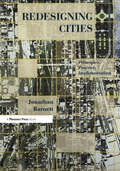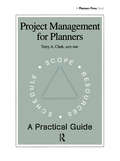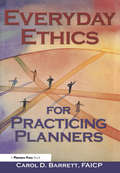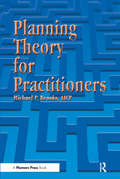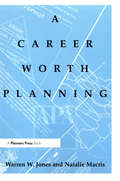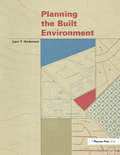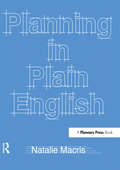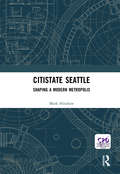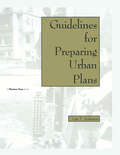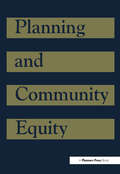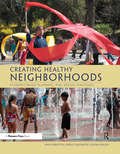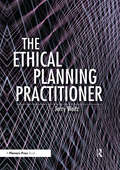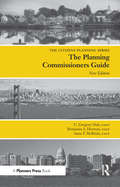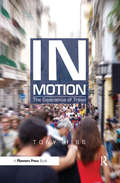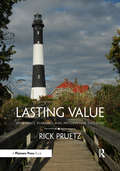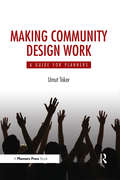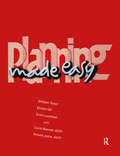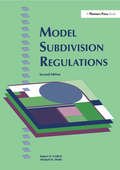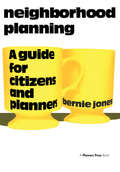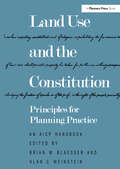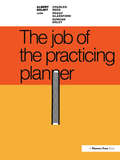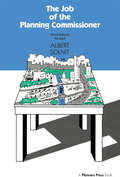- Table View
- List View
Planner's Estimating Guide: Projecting Land-Use and Facility Needs
by Arthur NelsonThe United States faces enormous changes in the next 25 years. Arthur C. (Chris) Nelson starts this book with a few projections: The population will grow by one-third to 375 million. We will need 60 million new housing units to house these people. There will be 60 percent more jobs, requiring 50 billion additional square feet of nonresidential space. The bottom line is that half of all development in 2030 will have been built since 2000. Nelson estimates the cost of new construction alone to be at least $20 trillion. This book gives planning practitioners a powerful tool to help decide where to put this new development. It does not advocate one development scenario over another, but it revolutionizes the job of estimating land-use and facility needs. Planner's Estimating Guide offers easy-to-use formulas and worksheets that are formatted in an Excel workbook on CD-ROM and carefully explained in the text. They make it easy to figure future requirements for countless scenarios. The workbook and text deal with a 20-year planning horizon for a fictitious county, but both the time projection and scale are entirely adaptable to myriad local circumstances. The program allows you to gather a first impression of future land-use needs, and revise it to reflect local limitations. For example, if the landscape in question won't support the land-use estimations, change the assumptions in the workbook to devise new estimates. The workbook shows the implications of growth based on standard assumptions; you can change the assumptions as needed to reflect local conditions — including public input — to see how outcomes change. Use the workbook as a model for testing local sensitivities with respect to land supply constraints and changes in policy assumptions. The results won't tell you what to do, but will reveal the numerical implications of different scenarios. The book is written principally for practitioners, and also for planning students as a primary or supplementary text. Used creatively, the powerful tools in Planner's Estimating Guide will help you determine the numerical implications of an almost infinite number of future circumstances that may affect your community.
Redesigning Cities: Principles, Practice, Implementation
by Jonathan BarnettThis book is recommended reading for planners preparing to take the AICP exam. Too often, no one is happy with new development: Public officials must choose among unappealing alternatives, developers are frustrated and the public is angry. But growing political support for urban design, developers' interest in community building and successful examples of redesigned cities all over the U.S. are hopeful signs of change. The author explains how design can reshape suburban growth patterns, revitalize older cities, and retrofit metropolitan areas where earlier development decisions went wrong. The author describes in detail specific techniques, materials, and technologies that should be known (but often aren't) to planners, public officials, concerned citizens, and others involved in development.
Project Management for Planners: A Practical Guide
by Terry A. ClarkThis book provides practicing planners with the knowledge of how to bring real world planning projects to a successful and efficient. It applies the five process groups of project management as identified in Project Management Institute's PMBOK® Guide and put them in the language of planners.
Everyday Ethics for Practicing Planners
by Carol Barrett"This book is on the suggested reading list for planners preparing to take the AICP exam. As veteran planner the author points out, the most troublesome conflicts for planners aren't between good and bad, they're between competing good, neither of which can be fully achieved. The 54 real-world scenarios described here typify the tough moral dilemmas that confront today's practioners. The author offers planners a way to recognize the ethical conflicts that arise in everyday practice, analyze them using ""practical moral reasoning,"" apply relevant sections of the AICP Code of Ethics and the APA/AICP Ethical Principles in Planning (both of which are included in full), and decide on the best course of action. The author tells a series of stories-each one a sticky situation that could confront a typical planner. Barrett points out the ethical issues, identifies possible alternatives, and cities relevant sections of the AICP Code. Finally, the author discusses the pros and cons of each alternative. Five particularly complex scenarios are especially intended for group discussion. Individuals studying for the AICP exam will find this book indispensable. But it also should be required reading for every planner who struggles to act ethically and for planning student who wants to understand how professionals define and serve the public interest. Planning agencies, private consulting firms, and planning commissions can use its realistic scenarios to jump start group discussions and workshops on ethical planning."
Planning Theory for Practitioners
by Michael BrooksThis book is recommended reading for planners preparing to take the AICP exam. In this new book, the author bridges the gap between theory and practice. The author describes an original approach-Feedback Strategy-that builds on the strengths of previous planning theories with one big difference: it not only acknowledges but welcomes politics-the bogeyman of real-world planning. Don't hold your nose or look the other way, the author advises planners, but use politics to your own advantage. The author admits that most of the time planning theory doesn't have much to do with planning practice. These ideas rooted in the planner's real world are different. This strategy employs everyday poltiical processes to advance planning, trusts planners' personal values and professional ethics, and depends on their ability to help clients articulate a vision. This volume will encourage not only veteran planners searching for a fresh approach, but also students and recent graduates dismayed by the gap between academic theory and actual practice.
Career Worth Planning: Starting Out and Moving Ahead in the Planning Profession
by Warren Jones Natalie MacrisNow that your planning degree is in sight or in hand, how and where can you find your "dream job?" Once you're on the job, what can you do to not just survive, but thrive and avoid common professional pitfalls? In A Career Worth Planning, two veteran planners offer a road map for success. Packed with practical information and useful advice, it is must reading for planning students, new planners, and experienced planners looking to advance their careers. Career questions can paralyze beginning planners. What are the differences between working for a public planning agency or a private consulting firm? What does an employer look for in a job candidate? How can you set yourself apart from other job hunters through your resume and in an interview? A Career Worth Planning answers these tough questions and many others. But landing a job is only half the battle. Once you're there, how do you negotiate the career ladder, even in the most difficult circumstances? Here are nuggets of wisdom on how to deal with a bad boss, identify crucial "insiders" who can make or break your success on the job, clarify ethical conflicts, manage political land mines, and yes, even evaluate your job satisfaction and determine when you're ready to move on. Wherever you are along your career path, this book will help you assess your skills, preferences, and work style, and find the planning niche that fits you.
Planning the Built Environment
by Larz AndersonPlanning the Built Environment takes a systematic, technical approach to describing how urban infrastructures work. Accompanied by detailed diagrams, illustrations, tables, and reference lists, the book begins with landforms and progresses to essential utilities that manage drainage, wastewater, power, and water supply. A section on streets, highways, and transit systems is highly detailed and practical. Once firmly grounded in these "macro" systems, Planning the Built Environment examines the physical environments of cities and suburbs, including a discussion of critical elements such as street and subdivision planning, density, and siting of community facilities. Each chapter includes essential definitions, illustrations and diagrams, and an annotated list of references. This timely book explains new physical planning methods and current thinking on cluster development, new urbanism, and innovative transit planning and development. Planners, architects, engineers, and anyone who designs or manages the physical components of urban areas will find this book both an authoritative reference and an exhaustive, understandable technical manual of facts and best practices. Instructors in planning and allied fields will appreciate the practical exercises that conclude each chapter: valuable learning tools for students and professionals alike.
Planning in Plain English: Writing Tips for Urban and Environmental Planners
by Natalie MacrisIn this volume, the author draws from more than a decade of editing experience to explain how to craft clear, understandable, and highly readable planning documents. The author suggests ways to overcome planners' most common writing foibles: acronymns, jargon, and overuse of the passive voice. And the author provides handy lists to transform mushy nouns into powerful verbs, pare down bloated sentences, and translate ""bureaucratese"" into everyday language. The author even includes practice exercises designed to help you recognize and overcome bad writing habits. But even the best writing skills won't help if your document is organized poorly and aimed at the wrong audience.The author also explains why it's essential to know who your readers are before you start writing and how to organize your work so that it will be easy to understand and use."
Citistate Seattle: Shaping A Modern Metropolis
by Mark HinshawWith style and humor, the author writes of special places in everyday Seattle. The author takes us to popular, high-profile landmarks like Pike Place Market as well as tucked-away gems — cozy cottages, trendy pubs, gracious apartment buildings, and vibrant urban villages — that flavor and enliven the city. The author shares his eye for unique, humanizing details of design, architecture, and function, bringing this colorful metropolis to life so vividly you'll practically smell the coffee they brew and sell on (almost) every street corner. Along the way, the author explains the public and private decisions that helped Seattle avoid the urban desolation that plagues other American cities. The author introduces many of Seattle's movers and shakers — mayors, developers, artists, and urban pioneers — who took it upon themselves to guide metropolitan Seattle along a different path.
Youth Planning Charrettes: A Manual for Planners, Teachers, and Youth Advocates
by Bruce RaceInvest in the future! Involve young people in planning. Learn how to design charrettes, starting with workshops and ending with lessons learned. This book explores various approaches to involving youth in schools, museums, and citizen groups. It's a complete guide to successful community charrettes for younger participants (K-8). First published in 1998. Routledge is an imprint of Taylor & Francis, an informa company.
Transportation & Land Use Innovations: When you can't pave your way out of congestion
by Reid EwingFirst published in 1997. Routledge is an imprint of Taylor & Francis, an informa company. This handbook introduces community leaders to an understanding of transportation mobility, offering suggestions to reduce congestion, automobile dependence, and vehicle miles of travel.
Guidelines for Preparing Urban Plans
by Larz AndersonWhile many authors have written about what urban plans should contain and how they should be used, this comprehensive book leads you step by step through the entire plan preparation process. Citing examples from across the country, Larz Anderson shows how to prepare, review, adopt, and implement urban plans. He explains how to identify public needs and desires, analyze existing problems and opportunities, and augment long-range general plans with short-range district and function plans. Anderson presents these guidelines as tasks. For each task, he explains the rationale behind it, recommends a procedure for completing it, and identifies the expected results. Throughout, Anderson encourages improvisation — he urges planners to adapt the guidelines to meet local needs. Excerpts from recently adopted general plans illustrate Anderson's points and provide examples of variations even within his recommendations. A related glossary gives comprehensive definitions to words that, though not technical, have meanings specific to the urban plan.
Planning and Community Equity: A Component of APA's Agenda for America's Communities
by American Institute of Certified PlannersThis thought-provoking book exhorts planners to establish community development programs that achieve greater social and economic equity. Some of the 13 chapters urge planners to incorporate community equity concerns into traditional planning areas such as transportation and economic development. Others challenge planners to get more involved in social areas such as urban education and community policing. Each chapter is authored by one or more professionals with expertise in the subject at hand. A helpful resource for planners who continue to tackle the problems of inequality.
Creating Healthy Neighborhoods: Evidence-Based Planning and Design Strategies
by Ann Forsyth Emily Salomon Laura SmeadGood housing. Easy transit. Food access. Green spaces. Gathering places. Everybody wants to live in a healthy neighborhood. Bridging the gap between research and practice, it maps out ways for cities and towns to help their residents thrive in placed designed for living well, approaching health from every side – physical mental, and social.
Ethical Planning Practitioner
by Jerry WeitzIf a local college gives a city planner tickets to a sold-out football game, is it wrong to take them – even if the planner pays? Should a planning consultant bid on a project that has a clearly unrealistic timeframe? Can a planning director moonlight for another agency? For practicing planners, potential ethics violations abound, and the eye of public scrutiny never blinks. Planners need a guide, and now they have it: the first guidebook based on the current revision of the AICP (American Institute of Certified Planners) Code of Ethics and Professional Conduct. The Ethical Planning Practitioner presents 76 scenarios, all real-life dilemmas based on the code's rules of conduct. Each scenario comes with tools to help planners explore the answers on their own, in a training session, or in a classroom. This vital handbook looks at everyday ethics the way planners need to see them, in black, white, and shades of gray – but most of all, clearly. It will not only instruct but inspire planners to strengthen the public's trust.
Planning Commissioners Guide: Processes for Reasoning Together
by C Gregory Dale Benjamin A Herman Anne McBrideAcross the country, communities rely on their planning commissions for guidance. But who guides the planning commissioners? This step-by-step guidebook gets new commissioners off on the right foot and helps experienced commission members navigate their roles. The authors, all practicing planners, have worked extensively with planning commissions for decades. They have watched commissioners scramble up a steep learning curve, sit in the hot seat of controversy, and strive to make sound decisions for the places they call home. In this helpful handbook, the authors share ideas, insights, and information to help commissioners succeed. Eight detailed chapters cover everything from the nuts and bolts of development applications to the nuances of legal issues to the part commissioners play in long-range planning. Readers will learn how to prepare for their first commission meeting, review a development plan, invite productive public input, and steer clear of ethical dilemmas. Added resources include a glossary of planning terms, a list of training resources, and the American Planning Association’s Statement of Ethical Principles in Planning. For anyone serving on a planning commission, The Planning Commissioners Guide is essential reading.
In Motion: The Experience of Travel
by Tony HissIn this extraordinarily wide-ranging, insightful, and revelatory book, Tony Hiss is the much-praised author of The Experience of Places delves into a unique and instantly recognizable (though previously undescribed) experience that can happen to us when we travel, a special understanding and ability that can leave us feeling exhilarated. He illustrates how throughout human history - from our ancestors walking upright for the first time to astronauts walking on the moon - we have repeatedly availed ourselves of this seemingly elusive quality, which he calls 'Deep Travel.' The sensation of Deep Travel can overtake us, Hiss says, whenever we tap into a sophisticated, wide-awake awareness we all possess. With a wealth of examples - from evocative accounts of his own journeys to celebrated travel writing across the centuries - Hiss identifies and rescues this powerful capacity and sets out simple techniques for accessing it no matter where we are.And this is only a jumping-off point for an original and penetrating explanation of how Deep Travel radically alters our perception of not only where we are but also when we are, by placing us in an 'extended present,' and how it acts as an open-sesame to enlarge and enrich the world around us. Going even further, he investigates how we can remain absolutely still but travel in time itself, as our horizons move backward to include layers of nature and human culture that have gone before, or project us forward to consider what our actions will mean to those who will inhabit our spot on earth a few generations from now.Whether travel takes you around the corner or around the world, once you've read In Motion, no journey will ever feel the same.
Lasting Value: Open Space Planning and Preservation Successes
by Rick PruetzAmericans are committing 'country-cide', says Rick Pruetz, FAICP, converting farms into suburban yards and channeling streams that once provided flood control, water purification, habitats, and recreational opportunities. But rather than rail against overdevelopment, this book celebrates communities succeeding in preservation. For ten years Pruetz explored communities that excel in saving their natural environment. In twenty-four illustrated vignettes, he captures the character of places from the volcanic range near downtown Albuquerque, New Mexico, to Minneapolis’s Grand Rounds park system, to farmland improbably preserved on Long Island. As the longtime city planner of Burbank, California, Pruetz offers more than an appreciation of these communities. He brings a planner’s-eye view of the practices behind their achievements. His detailed reports of creative preservation solutions mark the trail for planners, commissioners, and citizens who seek to preserve the green legacy in their own backyards.
Making Community Design Work: A Guide For Planners
by Umut TokerSince the earliest settlements, people have deliberated the issues that affect their future together. Making Community Design Work shows how planners can guide the process toward effective decision making and beneficial community design. This well-crafted book distills decades of community design experience into a sound conceptual framework of value to practicing planners as well as planning students. Umut Toker covers a broad range of planning scales and introduces field-tested tools for participatory decision making at regional, city, community, and site-specific levels. To succeed, any planning project must address both the physical space and its users. From setting goals to evaluating results, Making Community Design Work helps planners navigate the process of creating environments that meet the needs of the people they serve.
Planning Made Easy
by Carol Barrett William Toner Efraim Gil Enid Lucchesi Robert JoiceDeveloping a program to train planning commissioners and zoning board members takes a lot of time and effort. This manual makes the process easier. It covers the basics of community planning, zoning, subdivision regulation, and ethics. With chapters organized in discrete modules, it's ideal for both self-study and classroom use. Narratives explain general planning principles. Exercises encourage users to think about the planning issues in their communities. And worksheets reinforce important concepts. A complementary training guide, Training Made Easy, is also available. Planning Made Easy is published as looseleaf pages in a three-ring notebook.
Model Subdivision Regulations
by Robert H. Freilich Michael M. ShultzA major revision of a classic planning text. This book contains a complete model subdivision ordinance for city and county governments as well as more than 100 pages of legal commentary. The model regulations are generally compatible with all state statutes and work in urban, suburban, and rural settings. They show how communities can finance capital facilities, balance new development with existing surroundings, avoid exposure to the legal pitfalls of takings and substantive due process claims, and much more. Two new chapters cover public facilities impact fees and land readjustment. The chapter on impact fees includes a section on regulatory takings law that looks at how prominent U.S. Supreme Court cases have affected property rights, development, and regulation. Each section of the model regulations is followed by insightful commentary that supports, annotates, and documents the text. The authors explore the rationale for using various regulations, basing their arguments on existing statutory authority, case law, and federal constitutional requirements. The commentary identifies and explains changes from the original model regulations. Whether you're drafting new regulations or considering amendments to existing ones, you'll find Model Subdivision Regulations to be an invaluable reference.
Neighborhood Planning: A Guide for Citizens and Planners
by Bernie JonesFirst published in 1990. Routledge is an imprint of Taylor & Francis, an informa company. This guide explains neighborhood planning for both citizens and professionals. It explains what information to collect, where to get it, and how to assess it; how to pinpoint key issues, set clear goals, and devise strategies to achieve them; and how to package, implement, and update the final plan. Although this book could be used by citizens working alone, Jones advocates a team approach—citizens and professionals planning together. He highlights which tasks are best suited to the professional and how the planner should manage his role as intermediary between the city administration and residents. Jones also takes a detailed look at the neighborhood plan itself. Numerous maps illustrate how to inventory environmental features, land uses, circulation systems, and design features.
Land Use and the Constitution: Principles for Planning Practice (An\aicp Handbook Ser.)
by Douglas W. Kmiec Norman Williams Brian W. Blaesser Clyde W. Forrest Daniel R. Mandelker Alan C. WeinsteinThis practical handbook explains eight constitutional principles and applies them to real-world planning situations. These statements of principles reflect consensus opinions, but the book also discusses points of dissent. It includes detailed summaries of more than fifty U.S. Supreme Court cases affecting land-use planning, along with a comprehensive table of contents, a cross-referenced index, three matricies that relate sections of the book to one another, and a summary of constitutional principles that relates them to land-use planning techniques. All of these features make it easy to locate key constitutional principles quickly. This book is the result of a 1987 symposium that brought together two dozen leading practitioners and scholars in the fields of planning and law.
Job of the Practicing Planner
by Albert SolnitThis practical handbook demystifies development review. It explains the tools of local regulation and the technical, bureaucratic, and organizational skills planners need to be effective. Solnit shows how to work with developers, evaluate projects, and use fiscal impact analysis. Includes a section on planning ethics, checklists, and tips on negotiating. Chapters by contributing authors cover subdivision plats, site plans, appearance codes, and writing zoning reports. The Job of the Practicing Planner is a perfect introductory textbook in classes for planners and a practical handbook for people already on the job.
Job of the Planning Commissioner
by Albert SolnitA popular and practical guide on how to be an effective planning commissioner. Filled with checklists and outlines, it's both a good introduction and a handy reference. Includes a training checklist for new commissioners, criteria for keeping a master plan in working order, lists of tools to guide growth, advice on how to deal with professional staff, and dos and don'ts for conducting successful public meetings. This edition sharpens the focus on how commissioners and their staffs can operate under four core principles for planning commissioners: citizen involvement, smaller is better, living in a market-driven system, and orderly growth.

